 Fussy birds get what they deserve—that’s how some ornithologists explain the demise of birds like the Ivory-billed Woodpecker (Campephillus principalis) (Shugart, 2004). Ivory-bills foraged for insects by prying up the bark of large trees, leaving it to other woodpeckers to probe the deeper reaches. There’s a limited supply of suitably-clad trees so the birds needed large territories—at least 36 miles2 by one account (ibid.). Under this scenario agricultural land-clearing and hunting were just the final nails-in-the-coffin. One might be skeptical of explanations of extinction that blame the victim for choosing an unreliable niche. Trees die for many reasons–senescence, lightning, disease, over-browsing, floods, droughts, ice, wind-throw . . . all contributing to the dynamic patchwork that characterizes a healthy diverse woodland. The birds wouldn’t have evolved their habits if they didn’t have a reliable food-supply for millions of years and the behavioral elasticity to take advantage of the opportunities that arose and
Fussy birds get what they deserve—that’s how some ornithologists explain the demise of birds like the Ivory-billed Woodpecker (Campephillus principalis) (Shugart, 2004). Ivory-bills foraged for insects by prying up the bark of large trees, leaving it to other woodpeckers to probe the deeper reaches. There’s a limited supply of suitably-clad trees so the birds needed large territories—at least 36 miles2 by one account (ibid.). Under this scenario agricultural land-clearing and hunting were just the final nails-in-the-coffin. One might be skeptical of explanations of extinction that blame the victim for choosing an unreliable niche. Trees die for many reasons–senescence, lightning, disease, over-browsing, floods, droughts, ice, wind-throw . . . all contributing to the dynamic patchwork that characterizes a healthy diverse woodland. The birds wouldn’t have evolved their habits if they didn’t have a reliable food-supply for millions of years and the behavioral elasticity to take advantage of the opportunities that arose and 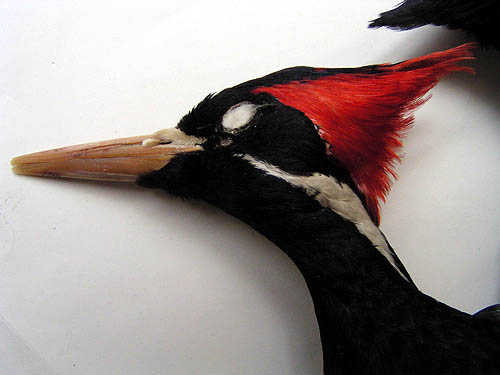 overcome challenges. Something significant altered the woodland disturbance regime. In that gap, and missing from the list above may reside an ice age ghost–keystone mega-herbivores that played a critical role in ancient forests–as the giants do today wherever they have survived (Owen-Smith, 1987). (picky eater photo borrowed from, woodpecker photo borrowed from)
overcome challenges. Something significant altered the woodland disturbance regime. In that gap, and missing from the list above may reside an ice age ghost–keystone mega-herbivores that played a critical role in ancient forests–as the giants do today wherever they have survived (Owen-Smith, 1987). (picky eater photo borrowed from, woodpecker photo borrowed from)
Central American trees with piles of wasted fruit first drew the attention of Janzen and Martin (1982). They suggested the dispersers with whom the plants had evolved had become extinct at the end of the Pleistocene and coined the term Ice Age “orphans” to describe the plants. Barlow (2000) identified mammoths, mastodons, ground sloths and other extinct mammals as the “ghosts” of the Ice Age that explained the surplus fruit and extravagant defenses of certain plants and animals (Byers, 1997).
C. principalis may be another Ice Age orphan. African elephants are notorious for rubbing, girdling, debarking and toppling trees (Coe and Coe, 1987). For millions of years Ivory-bills probably enjoyed a steady supply of dead and dying trees courtesy of mastodons, ground sloths, etc. . Habitat loss to humans and hunting may have just sealed their fate—perhaps they were doomed 12,000 years ago with the extinction of their keystone partners.
There is much natural history work that merits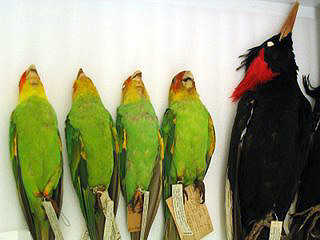 reexamination with Ice Age ghosts in mind. Hints of “missing links” abound in the accounts of extinct and endangered birds, for example, in the uncertainty about the extinction of the Carolina Parakeet (Conuropsis carolinensis). The parrots became scarce before the peak of plumage-hunting. They were said to be the bane of fruit-growers and may have been shot as pests, but McKinley (1960) notes the birds never earned a place on any bounty lists. He suggests honeybees were their undoing. Introduced by early European settlers, the bees competed with the parakeets for the tree-hollows they needed for nesting and roosting. As with the Ivory-bill, the lack of suitable tree habitat suggests a crimp in the supply chain–a disruption in the natural disturbance regime. Snags and the dead wood on living trees provide important habitat for 25% of the species that live in eastern forests today (Pennsylvania Game Commission, 2008). It’s vital to learn the right ecological lessons if we are to remediate the threat facing today’s woodland residents. (photo borrowed from)
reexamination with Ice Age ghosts in mind. Hints of “missing links” abound in the accounts of extinct and endangered birds, for example, in the uncertainty about the extinction of the Carolina Parakeet (Conuropsis carolinensis). The parrots became scarce before the peak of plumage-hunting. They were said to be the bane of fruit-growers and may have been shot as pests, but McKinley (1960) notes the birds never earned a place on any bounty lists. He suggests honeybees were their undoing. Introduced by early European settlers, the bees competed with the parakeets for the tree-hollows they needed for nesting and roosting. As with the Ivory-bill, the lack of suitable tree habitat suggests a crimp in the supply chain–a disruption in the natural disturbance regime. Snags and the dead wood on living trees provide important habitat for 25% of the species that live in eastern forests today (Pennsylvania Game Commission, 2008). It’s vital to learn the right ecological lessons if we are to remediate the threat facing today’s woodland residents. (photo borrowed from)
An erratic food supply, pesticides and lead poisoning are the oft-cited reasons for the near-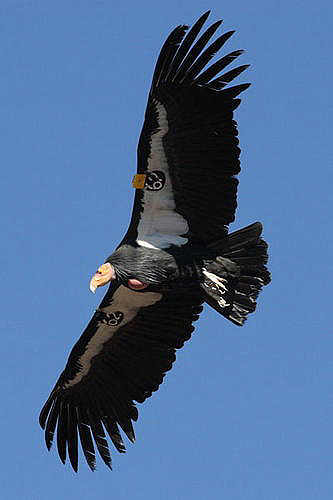 extinction of the California Condor, Gymnogyps californianus, but Cowles (1967) suggests as western scrubland became overgrown with brush, condors were blocked from exploiting key habitat and food sources. The birds need a stiff breeze and a running start to overcome the weight of a meal and fly (USDA Forest Service, Index of Species, 2008). With their runways blocked by high vegetation the birds remain airborne today over vast portions of their former range. Cowles points to fire suppression for the brush buildup, but the real cause may be the extinction of the browsers that once kept the vegetation down e.g. mastodons, camels (Camelops spp.), Harrington’s mountain goat (Oreamnos harringtoni) and the Shasta Sloth (Nothrotheriops shastensis). It may be no coincidence that the Condor disappeared from the Grand Canyon at about the same time the mega-browsers became extinct (Emslie (1987). (photo borrowed from)
extinction of the California Condor, Gymnogyps californianus, but Cowles (1967) suggests as western scrubland became overgrown with brush, condors were blocked from exploiting key habitat and food sources. The birds need a stiff breeze and a running start to overcome the weight of a meal and fly (USDA Forest Service, Index of Species, 2008). With their runways blocked by high vegetation the birds remain airborne today over vast portions of their former range. Cowles points to fire suppression for the brush buildup, but the real cause may be the extinction of the browsers that once kept the vegetation down e.g. mastodons, camels (Camelops spp.), Harrington’s mountain goat (Oreamnos harringtoni) and the Shasta Sloth (Nothrotheriops shastensis). It may be no coincidence that the Condor disappeared from the Grand Canyon at about the same time the mega-browsers became extinct (Emslie (1987). (photo borrowed from)
Lack of mega-carrion is often blamed for the extinction of the incredible Teratornis spp. And the other great Ice Age condors (Wetmore, 1956), but hints from Africa point to more ghosts.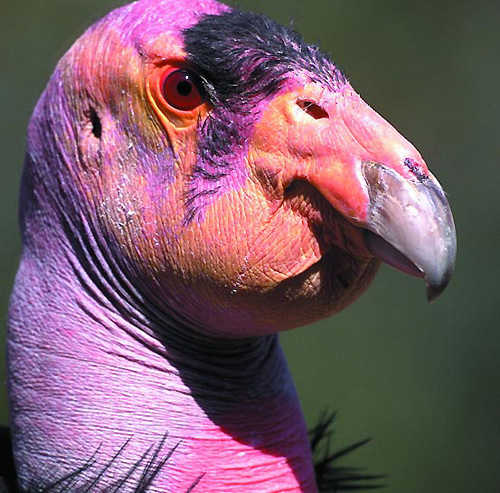 Condors need large amounts of calcium in the breeding season for their eggs and nestlings. Meat contains very little—11 mg per 100 g (Mundy and Ledger, 1976). Calcium shortage has been linked to the small clutch size of G. californianus–one egg usually—and the very slow growth rate of their chicks (Snyder and Snyder, 2000), plus the aforementioned lead poisoning (Pb2+ readily supplants Ca2+ in their eggshells and bones). Condors normally get their calcium by swallowing the bones of small animals or the chips of bone left by scavengers at larger carcasses–the birds can’t break large bones. Mundy and Ledger (1976) link the endangered status of the Cape Griffon Vulture (Gyps coprotheres) to the extirpation of bone-crushing scavengers, especially hyenas, over broad areas of S. Africa. 20% of the bone fragments they collected at the nests of Whitebacked Vultures
Condors need large amounts of calcium in the breeding season for their eggs and nestlings. Meat contains very little—11 mg per 100 g (Mundy and Ledger, 1976). Calcium shortage has been linked to the small clutch size of G. californianus–one egg usually—and the very slow growth rate of their chicks (Snyder and Snyder, 2000), plus the aforementioned lead poisoning (Pb2+ readily supplants Ca2+ in their eggshells and bones). Condors normally get their calcium by swallowing the bones of small animals or the chips of bone left by scavengers at larger carcasses–the birds can’t break large bones. Mundy and Ledger (1976) link the endangered status of the Cape Griffon Vulture (Gyps coprotheres) to the extirpation of bone-crushing scavengers, especially hyenas, over broad areas of S. Africa. 20% of the bone fragments they collected at the nests of Whitebacked Vultures 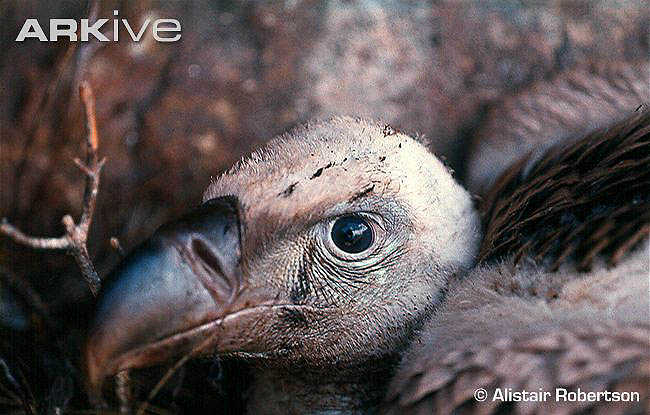 (Gyps africanus) in Zimbabwe, where the carnivores are extant, showed visible carnivore tooth-damage. Without sufficient calcium the bones of the Griffon chicks are deformed and break under stress like simple pre-flight exercise; often they are malnourished, their digestive tracts clogged with the detritus they ingest seeking calcium (e.g. ceramic fragments, stones, etc.) (ibid). The extinction of the American hyena (Chasmaporthetes ossifragus) and other carnivores may have precipitated a similar calcium-crisis in North American condors. (photo by Alistair Robertson)
(Gyps africanus) in Zimbabwe, where the carnivores are extant, showed visible carnivore tooth-damage. Without sufficient calcium the bones of the Griffon chicks are deformed and break under stress like simple pre-flight exercise; often they are malnourished, their digestive tracts clogged with the detritus they ingest seeking calcium (e.g. ceramic fragments, stones, etc.) (ibid). The extinction of the American hyena (Chasmaporthetes ossifragus) and other carnivores may have precipitated a similar calcium-crisis in North American condors. (photo by Alistair Robertson)
Ecologists have long focused on human activity and the historic forces affecting the fate of wildlife, overlooking the echoing effects of the ice ages. If we are to preserve the vanishing remnants of the natural world it’s imperative that we understand the essential forces once supplied by the Pleistocene mega-mammals and arrange for substitutes where possible, or create them ourselves by artificial means. . . Dave
References
Barlow, C. 2000. The Ghosts of Evolution: Nonsensical fruit, missing partners, and other ecological anachronisms. Basic Books. New York, NY.
Byers, J. 1997. American Pronghorn: Social adaptations and the ghosts of predators past. University of Chicago Press. Chicago, IL.
Coe, M. and Coe, C. 1987. Large herbivores, acacia trees and bruchid beetles, South African Journal of Science 83: 624-635.
Snyder, N.F.R. and Snyder, H.A 2000. The California Condor: a saga of natural history and conservation.
Cowles, R.B. 1967. Fire suppression, faunal changes and condor diets. Tall Timber Fire Ecology Conference 7: 217-224.
Emslie, S.D. 1987. Age and diet of fossil California Condor in Grand Canyon, Arizona. Science 237: 768-770.
Janzen, D.H. and Martin, P.S. 1982. Neotropical anachronisms: the fruits the Gomphotheres ate. Science 215: 19-27.
McKinley, D. 1960. The Carolina Parakeet in pioneer Missouri. The Wilson Bulletin 72: 274-287.
Mundy, P.J. and Ledger, J.A. 1976. Griffon Vultures, carnivores and bones. South African Journal of Science 72: 106-110.
Owen-Smith, R.N. 1987. Pleistocene extinctions: the pivotal role of megaherbivores. Paleobiology 13: 351-362.
Pennsylvania Game Commission. 2008.
Shugart, H. H. 2004. How the Earthquake Bird Got Its Name and Other Tales of an Unbalanced Nature. Yale University Press New Haven, CT
USDA Forest Service, Index of Species Information 2008.
Wetmore, A. 1956. Birds of the Pleistocene in North America. Smithsonian Miscellaneous Collections 138(4): 1-24.

Interesting point Dave. I’d always heard the idea that hurricanes (and their tree killing power) were needed for ivory bill foraging. Never thought of megafauna in the equation…
On a similar note – has anybody noticed that a good percentage of thornless honey locust trees are thriving these days? Not the sunburst cultivar planted in towns, but the wild ones out in the woods.
Pete, I’m just finishing a post about the honey locust, but this is news to me. I understand a lot of the thornless trees are clones of one tree in Wisconsin. The experts have expressed some concern about the lack of genetic diversity in the cities as it gets planted everywhere, but I hadn’t picked up on any problems with it showing unusual vigor. I understand it breeds true and its seedlings are thornless–could you be seeing the progeny of one early escapee?
Could be, but they seem to be scattered in lots of places. My guess is that these are just mutant trees that survived the seedling stage and are now too big for any serious threat from herbivores (ie: no mastadons around to chomp them)
Dave, Your comment on megamammals (mammoths, mastodons, sloths, etc.) creating a ‘woodland disturbance’ community brought back memories of elephant watching outside of Kruger National Park in South Africa. We observed a single elephant, probably a male recently outed by its family matriarch, pulling trees (3-6 inches in diameter) out of the ground, rotating them to a horizontal position on its tusks, and then stripping the bark as we would eat an ear of corn. I was impressed that the animal would only ingest two to three feet of bark, discard the 20-30foot tree and then pull another to extract bite or two. This process certainly created hunting ground for taxa such as the ivory bill and habitat for a variety of smaller animals. I wondered then, as now, if this behavior created the parkland (lots of grass on the substrata) or if a preexisting parkland environment permitted sufficient space between trees for the giant to enter and feed. Either way, you have to give the elephant a gold star for parkland maintenance. Megamammals do modify the landscape.
Holmes, Jachmann and Bell (1985) studied the kinds of trees African elephants push over and noted some important distinctions they make. Elephants don’t destroy trees randomly. Unpalatable trees tend to be pushed over regardless of their size, while palatable ones aren’t pushed down until they grow out of reach of the elephants. Many palatable species respond to trunk breakage by growing multiple stems from the base (i.e. coppicing) so the elephants’ actions, in addition to encouraging surrounding new growth by opening the forest canopy and admitting sunlight, tend to kill unpalatable trees selectively and maintain palatable ones in a form that maximizes forage for thems elves and other browsers—a vivid example of the keystone role megaherbivores play in habitat creation and maintenance. The enhanced ability mega-browsers like elephants, and mastodons and Megalonyx had to survive on high fiber diets means they played a constant role in recycling the nutrients locked up in mature woody plants, and making way for younger more palatable plants to flourish for the benefit of the entire animal community.
Reference
Jachmann, H. and Bell, R.H.V. 1985. Utilization by elephants of the Brachystegia woodlands of the Kasungu National Park, Malawi. African Journal of Ecology 23: 245-258.